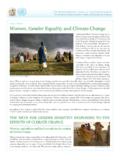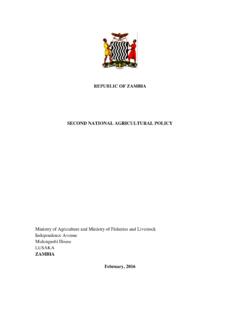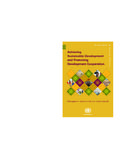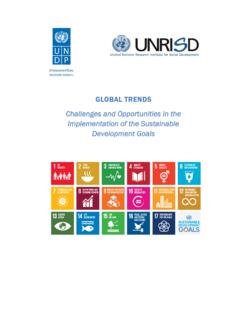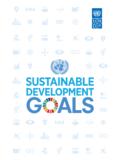Transcription of TACKLING CLIMATE CHANGE THROUGH RURAL WOMEN’s ...
1 TACKLINGCLIMATE CHANGETHROUGHRURAL WOMEN sEMPOWERMENT FAO is committed to mainstreaming gender equality into CLIMATE -related planning processes, promoting inclusive and diversified sustainable food and agriculture systems to help reduce RURAL poverty and avoid crises linked to distress migration, conflict over resources and discrimination over social groups FAO's Corporate CLIMATE CHANGE Strategy, 2017 Key MessagesRural women increasingly face the challenge of having to adapt their production systems to the impacts of CLIMATE CHANGE and natural disasters. There are large differences between men and women in terms of impacts, vulnerabilities, responses and capacity to adapt to CLIMATE CHANGE depending on individuals access to resources, assets, information, services and decision-making play an important role in CLIMATE CHANGE adaptation and mitigation given their wide-ranging functions in the agricultural sector and in livestock, fisheries, energy, forestry, water and land management equal access for women to productive resources, CLIMATE -smart and labour-saving technologies and practices is crucial to enhance the sustainability of agriculture, achieve food security and nutrition, eradicate poverty and build the resilience of RURAL households and gender -differentiated impacts of CLIMATE CHANGE The adverse effects of CLIMATE CHANGE and the unprecedented natural resource depletion pose serious threats to food security and nutrition, especially for small-scale food producers.
2 RURAL women have more limited access to productive resources, services, education and employment opportunities while experiencing, excessive workloads and limited decision-making power1. CLIMATE CHANGE impacts women and men differently. Crop failureFuelshortageWaterscarcityNaturald isastersDiseaseDisplacementConflictHouse hold foodprovision:Increasedagricultural workWomen s greater incidenceof mortalityLoss of lives and livelihoods;violence against womenForced migrationincreases women svulnerabilityLack of access tohealth care; women s burdenas care giversHousehold fuel provision:more time forfuelwood collectionHousehold water provision:contaminated water; more timefor water collectionclimate changeImpact ONgender equalitYCrop failureFuelshortageWaterscarcityNaturald isastersDiseaseDisplacementConflictHouse hold foodprovision:Increasedagricultural workWomen s greater incidenceof mortalityLoss of lives and livelihoods;violence against womenForced migrationincreases women svulnerabilityLack of access tohealth care; women s burdenas care giversHousehold fuel provision:more time forfuelwood collectionHousehold water provision:contaminated water.
3 More timefor water collectionclimate changeImpact ONgender equalitYThe gender -differentiated impacts of CLIMATE CHANGE in RURAL areas Greater food and nutrition insecurity CLIMATE CHANGE poses serious threats to the lives and livelihoods of small-scale producers, women in particular. Evidence shows that women are more likely to be food insecure than men in every region of the world2. Increased workload of women and girls to collect water and firewoodThe work burden of fetching water and collecting firewood usually falls on women and girls, who have to travel long distances to fulfill the needs of their families. Firewood and water collection exposes women to the risk of physical and sexual natural disasters hit in India, girls were more likely stunted and underweight than boys and in Andhra Pradesh, twice as many women as men reported eating less in response to 66% of households in Sub-Saharan Africa, 55 % in South and South-eastern Asia, and 31% in Latin America rely on firewood collection for cooking, done almost exclusively by girls3.
4 In Sub-Saharan Africa alone about 40 billion hours per year are spent to collect water; that s the same as a whole year of labor by France s entire workforce4. In Kenya, fetching water may use up to 85% of a woman s daily energy intake; in times of drought women spend up to eight hours a day in search of of disasters and migration Natural disasters and their impacts on food insecurity may also fuel conflicts and migratory flows. Women usually migrate later than men and when they do, they may leave behind children with other family members. Additionally, they suffer more than men from the psychosocial impacts of migration because they have to take care of family members while disregarding their own distress and they are also victims of gender -based violence. Agriculture remains critical for the family remaining at home, in particular for female-headed households. Limited land ownership Land is a fundamental resource for agricultural production, and provides a crucial source of resilience to CLIMATE risks.
5 Women s lack of rights to land ownership denies them also user rights, including the rights to plant trees and build soil control , less than 15% of agricultural land is held by women6. Studies show that women, boys and girls are 14 times more likely than men to die during natural disasters7. 70% of fatalities from 2004 Asian tsunami, and 96% of 2014 Solomon Island floods8 were women and Tajikistan men migrate for work in neighboring Russia, and as a result more than 55% of those employed in agriculture are women. A similar trend is true across South and Central Asia. Conversely, in Bangladesh, crop failure and flooding disproportionately increase the rate of migration by women, especially those with less secure access to land . >15% gender equality in global frameworks and national commitmentsThere is strong focus on gender equality and women s empowerment in the 2030 Agenda for Sustainable Development, both in the form of a dedicated Goal on gender Equality (SDG5) and a cross-cutting theme with more than 30 related gender targets across other SDGs.
6 There is increasing global political commitment to address gender and CLIMATE changeThe gender Action Plan of the UNFCCC, adopted at COP23 in November 2017 under the Lima work programme on gender , seeks to: Advance women s full participationPromote gender -responsive CLIMATE policy Mainstream gender perspectives in the implementation of the Convention and work of Parties and all stakeholders at all levels including adaptation, mitigation, capacity-building, technology and finance policies, plans and in Nationally Determined Contributions (NDC)6518countries made at least one reference to gender equality or women countries recognize the role of women in mitigation, in relation to energy emissions, sustainable or biomass energy, and livestock12countries recognize the importance of building women s resilience capacity and disaster risk reduction33 Indentify gender as a cross-cutting policy priority, or commit to either integrate or mainstream gender in all CLIMATE CHANGE actions and strategies32 countries refer to women in the identification of vulnerable groups and regions affected by CLIMATE CHANGE , while only 2 regard them as agents of CHANGE <40%Over 40% of NDCs make reference to of countries mention the agriculture sector in their equality is mentioned in 75% of NDC submissions from Sub-Saharan Africa.
7 Opportunities for closing the gender gap in agriculture FOR CLIMATE resilience Women play a major role in agriculture accounting for 43 percent of the agricultural labour force in developing countries, a figure that raises up to more than 60 percent in parts of South Asia and in Africa12. Women have an important role in conservation efforts, such as seed saving, growing and preserving underutilized species. These species also have value as potential gene sources in case of collapse of commercially viable varieties, that helps decrease their vulnerabilities to CLIMATE shocks and improve food security. There are important untapped opportunities in the global phenomenon of the feminization of agriculture. Female farmers play important roles in maintaining knowledge about different plant varieties and deciding which crops to plant, particularly as many men migrate away from the farm. Their empowerment can significantly contribute to building the household resilience to CLIMATE impacts13.
8 Women s ownership of productive assets is positively linked to their uptake of CLIMATE -smart practices and soil conservation techniques. For instance, where women have secure land rights, greater yields and increased food security are also observed14. Increasing women s awareness and access to information and knowledge about CLIMATE -smart agriculture options will lead to greater uptake of these technologies and practices, and enhance the resilience of entire households and communities and food systems to CLIMATE -related shocks and access to resources and power for food security in the face of CLIMATE changeFAO s gender -responsive programming in the context OF CLIMATE CHANGE FAO support actions aimed at achieving sustainable and inclusive agricultural development for food security and nutrition under a changing CLIMATE spans interventions at various levels. Closing policy and institutional gender gaps FAO supports countries in addressing gender issues into their National Adaptation Plans THROUGH the Nap-Ag Programme15.
9 The programme s aim is to integrate gender equality into adaptation planning, into relevant budgets and policies for agriculture at various levels, working with Parliamentarians, Central Planners, District-level planners, and non-government actors. The programme provides technical trainings on gender analysis and mainstreaming in adaptation planning; incorporates of sex-disaggregated data and gender analysis into agriculture censuses and impact evaluations; as well as tools for countries to promote women s empowerment and CLIMATE resilience in agricultural value chain development, as currently piloted in various countries (Uganda, Zambia, the Philippines, Nepal and Uruguay). FAO s Mitigation of CLIMATE CHANGE in Agriculture (MICCA)16 Programme has mainstreamed gender issues into each of its work components. For example, in Kenya and the United Republic of Tanzania, sex-disaggregated data were collected to monitor and report on the barriers and incentives that men and women face in adopting CLIMATE -smart approaches and practices.
10 Women were involved in the selection of locally-adapted CSA practices and in the identification of labour-saving technologies. In addition, gender equality was integrated into the Kenya s Nationally Appropriate Mitigation Action for the dairy sector and into the CSA Guidelines prepared for the United Republic of capacities & skills of women smallholder farmers FAO s Dimitra programme is a participatory information and communication project which contributes to improving the visibility of RURAL populations, women in particular. More than 400 Dimitra Clubs17 were set up in Senegal as part of a FAO project to strengthen producers capacities to handle shocks, adapt to CLIMATE threats, improve food and nutrition security and increase incomes. Achievements in Mali include the upscaling of the Farmer Field School approach in over 130 municipalities; the adoption of improved seeds in 250 villages and the dissemination of 13 improved and adapted varieties. Four agroforestry zones were created THROUGH barriers made from trees and shrubs managed by producer organizations, 75 percent of whom are women.










